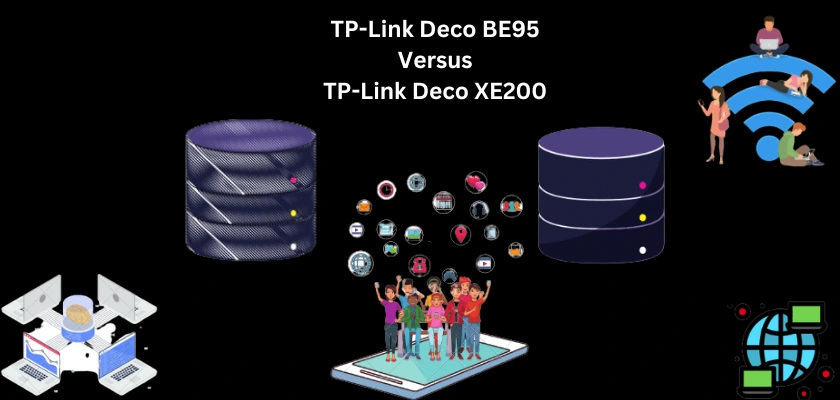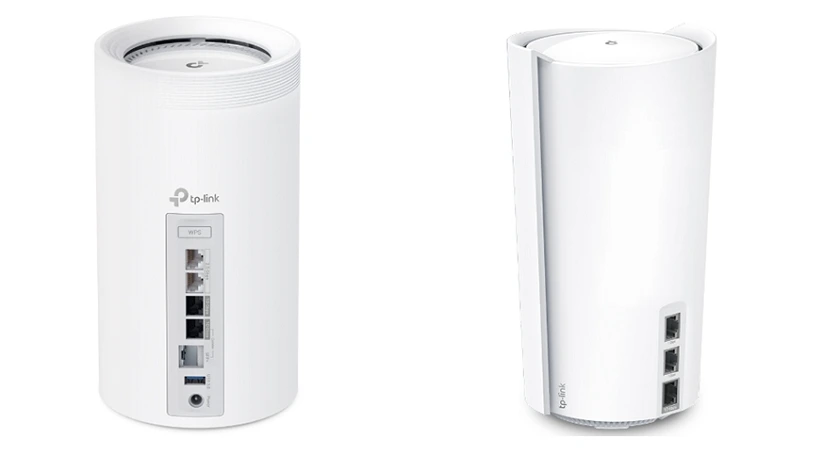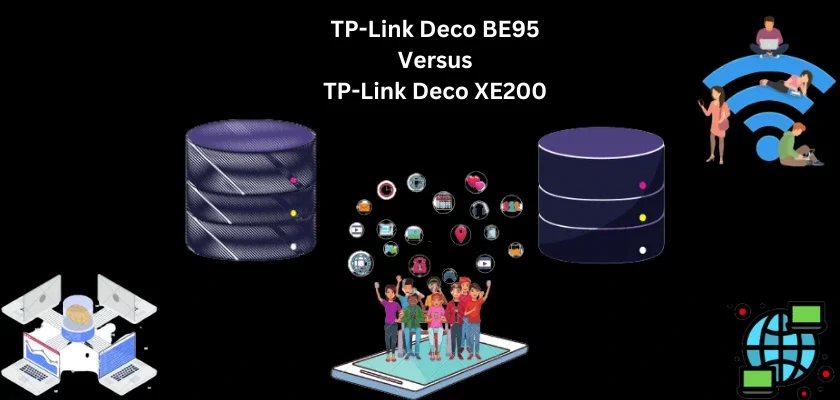
The attraction that Whole Home Mesh Wi-Fi systems like the TP-Link Deco BE95 (BE33000), and the TP-Link Deco XE200 (AXE11000) bring can only be imagined. These devices are captivating and extremely powerful.
In today’s world, having a reliable and fast internet connection is a necessity. Whether it’s for work, entertainment, or staying connected with loved ones, a strong and stable Wi-Fi signal is crucial. With the increase in smart home devices, the demand for seamless internet connectivity throughout the entire house has also increased; that’s where these Wi-Fi mesh systems come into play.
TP-Link is a well-known brand in the Wi-Fi mesh systems market, offering several options to choose from. Two of their very remarkable models are the TP-Link Deco BE95 (BE33000) and the TP-Link Deco XE200 (AXE11000). Both offer top-notch performance and features, making them great options for anyone looking for a reliable and fast Wi-Fi mesh system. In this review, we will compare the TP-Link Deco BE95 (BE33000) with the TP-Link Deco XE200 (AXE11000), highlighting their similarities, differences, and what makes them stand out from each other.
We will also explore which one might be the best fit for different types of users based on their needs and preferences. So, if you’re in the market for a Wi-Fi mesh system and considering either of these options, keep reading to find out which one might be the best for you.

Overview of the TP-Link Deco BE95 (BE33000)
The TP-Link Deco BE95 (BE33000) measures 5.04 × 5.04 × 9.29 in (128 × 128 × 236 mm), making it easy to install in your home. The device comes with a 2-pack and 1-pack that includes RJ45 Ethernet cables, power adapters, and quick installation guides.
Designed with the end-user in mind, the TP-Link Deco BE95 (BE33000) employs the latest wireless technology standards, including Wi-Fi 7 IEEE 802.11be/ax 6 GHz, IEEE 802.11be/ax/ac/n/a 5 GHz, and IEEE 802.11be/ax/n/b/g 2.4 GHz. With these standards, you get faster speeds and more bandwidth to support your connected devices’ demands.
The TP-Link Deco BE95 (BE33000) features quad-band capability that distributes devices to different bands for optimal performance. The greenfield 6 GHz band brings more bandwidth and faster speeds to give you more reliable wireless connections.
This device also features AI-driven mesh technology. This lets it automatically learn your network environment to provide the ideal Wi-Fi coverage for your home. Additionally, the Deco BE95 (BE33000) features 12x high-gain internal antennas that form a signal-boosting array, providing broader coverage in more directions and larger areas.
This device offers you various working modes, including router and access point modes, giving you the flexibility to choose the mode that suits your needs. Furthermore, the Deco BE95 supports multi-link operation, 320 MHz channel, 4K-QAM, and multi-RUs, allowing you to customize your network settings to fit your preferences.
The TP-Link Deco BE95 (BE33000) offers a very high Wi-Fi capacity with 16 streams, four streams on each band, and 4×4 MU-MIMO that simultaneously communicates with multiple MU-MIMO clients. Additionally, OFDMA technology enables the device to communicate with multiple Wi-Fi 7 clients simultaneously.
The device is built with 1 x USB 3.0 port, 2 x 2.5 Gbps WAN/LAN ports, 1 x 10 Gbps WAN/LAN port, and another 10 Gbps RJ45/SFP+ Combo ports. All of these deliver you exceptional WAN/LAN and auto-sensing connectivity, with more flexibility when it comes to connecting your devices. The TP-Link Deco BE95 (BE33000) also features HomeShield parental controls, allowing you to customize your profiles, content filter library, family time, bedtime, off time, time rewards, family online time ranking, and pause the internet. You can also get weekly and monthly reports of your network’s performance.
Overview of the TP-Link Deco XE200
The TP-Link Deco XE200 (AXE11000) is designed to provide exceptional Wi-Fi speeds and coverage, making it a great option for larger homes with multiple floors and rooms. Beginning with the package, the TP-Link Deco XE200 (AXE11000) comes in either a 1-pack or 2-pack depending on your needs. Each package includes the Deco XE200 unit(s), an RJ45 Ethernet cable, power adapter(s), and a Quick Installation Guide. Whether you have a small apartment or a large home, the TP-Link Deco XE200 can provide the coverage and performance you need for a seamless Wi-Fi experience.
One of the standout features of the TP-Link Deco XE200 (AXE11000) is its support for the Wi-Fi 6E standard. This makes it provide faster and more efficient data transfer speeds. This standard supports IEEE 802.11ax 6 GHz, IEEE 802.11ax/ac/n/a 5 GHz, and IEEE 802.11ax/n/b/g 2.4 GHz, providing fast and reliable connectivity on all three bands.
Another impressive feature of the TP-Link Deco XE200 is its range. The system is designed to cover 4-6+ bedroom houses with a 2-pack, and 1-3 bedroom houses with a 1-pack. This means you can enjoy seamless internet connectivity throughout your entire home, without worrying about dead spots or weak signals.
The TP-Link Deco XE200 (AXE11000) utilizes the TP-Link mesh technology to link multiple Deco units together to provide seamless coverage. This technology can also use an optional Ethernet backhaul to link Deco units, which provides even better performance and coverage.
Now, let’s take a look at the AI-driven mesh. This feature intelligently learns the network environment in your home. Then, it provides ideal Wi-Fi coverage unique to your home. As such, you can enjoy a customized and optimized Wi-Fi experience, without needing to manually tweak settings or configurations.
Even better, the Wi-Fi mesh comes with 16× high-gain internal antennas. These form a signal-boosting array to cover more directions and large areas. It ensures that you can enjoy fast and reliable internet connectivity throughout your entire home, even if you have multiple floors or thick walls.
This review is incomplete without mentioning the tri-band support. This is great for bandwidth-intensive activities such as online gaming or 4K streaming. The system can also distribute devices to different bands for optimal performance, ensuring that each device gets the best possible speed and connectivity.
The TP-Link Deco XE200 (AXE11000) also comes with beamforming technology, which concentrates wireless signal strength towards clients to expand Wi-Fi range. This means that you can enjoy a stronger and more stable internet connection, even if you’re far away from the main Deco unit.
Overall, the TP-Link Deco XE200 (AXE11000) is an excellent option for anyone looking for a powerful and reliable Wi-Fi mesh system. With its advanced Wi-Fi standards, AI-driven mesh technology, and tri-band support, it offers exceptional speeds and range for even the largest homes. Its range of management features, security protocols, and parental controls also make it an excellent choice for families and those who prioritize security and control over their home network.
What are the differences between the TP-Link Deco XE200 (AXE11000) and TP-Link Deco BE95 (BE33000)
To better understand the differences between both systems, we’ll examine them based on different criteria.
Wi-Fi Standards and raw Wi-Fi speed
The TP-Link Deco BE95 (BE33000) offers Wi-Fi 7 technology, which provides blazing-fast speeds across all of its bands. Specifically, it supports IEEE 802.11be on the 6GHz band, with speeds of up to 11520 Mbps on both 6GHz- 1 and 6GHz- 2 bands. On the 5GHz band, it supports IEEE 802.11be/ax/ac/n/a, with speeds of up to 8640 Mbps. And on the 2.4GHz band, it supports IEEE 802.11be/ax/n/b/g, with speeds of up to 1148 Mbps.
The TP-Link Deco XE200 (AXE11000), on the other hand, uses Wi-Fi 6E technology, which is a step down from the Wi-Fi 7 supported by the TP-Link Deco BE95 (BE33000). Specifically, it supports IEEE 802.11ax on the 6GHz band, with speeds of up to 4804 Mbps using the HE160 standard. On the 5GHz band, it also supports IEEE 802.11ax/ac/n/a, with speeds of up to 4804 Mbps. Finally, on the 2.4GHz band, it supports IEEE 802.11ax/n/b/g, with speeds of up to 1148 Mbps.
So, in terms of raw Wi-Fi speeds, the TP-Link Deco BE95 comes out ahead of the TP-Link Deco XE200. It offers faster speeds across all of its bands, with support for the latest Wi-Fi 7 technology. However, it’s important to note that in real-world usage, you may not always be able to achieve the maximum speeds advertised by these devices. Other factors, such as the distance between your devices and the access points, as well as any interference from nearby devices, can impact your actual speeds.
How do the TP-Link Deco BE95 (BE33000) and TP-Link Deco XE200 (AXE11000) rival in terms of Wi-Fi range?
Basically, both the TP-Link Deco BE95 and TP-Link Deco XE200 offer strong coverage with similar technologies. They both use TP-Link Mesh Technology and optional Ethernet backhaul to link Deco units together, providing seamless coverage across your home.
They also both use AI-Driven Mesh technology to learn and adapt to your network environment, as you’ve probably deduced so far. On the flipside, in terms of their antennas, the TP-Link Deco XE200 has a few more internal high-gain antennas than the TP-Link Deco BE95. This may give it a slight edge in coverage. Additionally, the XE200 uses beamforming to concentrate wireless signal strength towards clients, further extending the Wi-Fi range. However, overall, both devices deliver strong and reliable Wi-Fi coverage for most users.
As for the Wi-Fi capacities, both routers offer very high performance and cutting-edge technologies. The TP-Link Deco XE200 has slightly more advanced MU-MIMO technology, which can communicate with more MU-MIMO clients simultaneously. But, the TP-Link Deco BE95 has a quad-band feature, which can distribute devices to different bands for optimal performance, and it can simultaneously communicate with multiple Wi-Fi 7 clients using OFDMA technology. Ultimately, both devices will provide more than enough Wi-Fi capacity for most users, ensuring fast and reliable connectivity for all of their devices.
How are both Wi-Fi meshes similar?
When it comes to advanced functions, security, software protocols, and parental controls, the TP-Link Deco BE95 (BE33000) and TP-Link Deco XE200 (AXE11000) share many similarities.
Both mesh systems offer Multi-Link Operation (MLO), which allows for seamless device roaming between nodes, as well as a 320 MHz Channel and 4K-QAM for enhanced performance. Additionally, they both have Multi-RUs, which means they can communicate with multiple devices simultaneously.
Users of either mesh device can also take advantage of voice control through Amazon Alexa and Google Assistant, as well as an IoT Network for smart home devices.
In terms of security, the TP-Link Deco BE95 and TP-Link Deco XE200 feature an SPI Firewall and Access Control. They also offer TP-Link’s HomeShield Security, which includes real-time IoT protection, malicious site blocking, intrusion prevention, and DDoS attack prevention. Home Network Scanner is also available on both meshes to scan for vulnerabilities on connected devices.
Both mesh systems support IPv4 and IPv6 protocols, and they come equipped with HomeShield Parental Controls for managing internet access for children. With custom profiles, a professional content filter library, and features such as Family Time, Bedtime, Off Time, and Time Rewards, parents can easily manage their kids’ online activity. Both meshes also offer the ability to pause internet access and provide weekly and monthly reports.
Overall, whether you choose the TP-Link Deco BE95 or the TP-Link Deco XE200, you can be rest assured that you’re getting advanced functions, robust security, software protocols, and parental controls to keep your home network running smoothly and securely.
Final Thoughts
In conclusion, both the TP-Link Deco BE95 (BE33000) and TP-Link Deco XE200 (AXE11000) Mesh Wi-Fi systems offer a wide range of advanced features and functionalities that can enhance your home network experience. From multi-link operation and 320 MHz channel to advanced security features and parental controls, both systems are designed to cater to the needs of modern-day users.
When making your decision, it’s important to consider the value for money of each system. While the TP-Link Deco BE95 may come at a higher cost, it offers more advanced features and broader coverage. On the other hand, the XE200 may be a more affordable option that still offers top-notch features and functionalities.
Whichever option you choose, both the TP-Link Deco BE95 and TP-Link Deco XE200 Mesh Wi-Fi systems provide a seamless and reliable home network experience that can take your online activities to the next level.
You may also want to see our review of the TP-Link Deco X50 Outdoor and TP-Link Deco X50 PoE.




